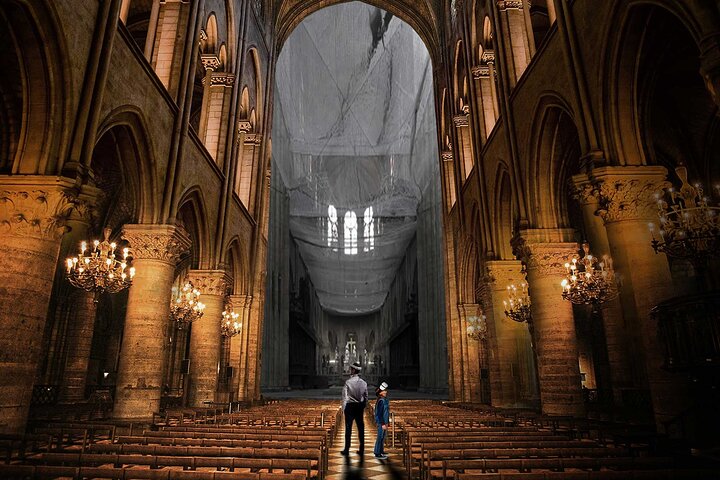


French President Emmanuel Macron conducted a televised tour of the newly refurbished Notre-Dame cathedral in Paris, praising the workers who made the "impossible" task of restoration possible. The Gothic jewel, which suffered major damage during a fire in 2019, has been rescued, renovated, and now offers visitors a breathtaking visual treat. The official "entry" into the cathedral is set for December 7, followed by the first Catholic Mass the day after.
Notre-Dame's Revival: A Testament to French Resilience
The iconic Notre-Dame Cathedral in Paris has emerged from the devastating fire of 2019 as a symbol of resilience and architectural triumph. French President Emmanuel Macron recently led a televised tour of the refurbished cathedral, paying tribute to the workers who made the seemingly impossible task a reality.
Background
On April 15, 2019, a catastrophic fire ravaged the Notre-Dame Cathedral, threatening its centuries-old legacy. The inferno caused extensive damage to the roof, spire, and interior. In the aftermath of the disaster, President Macron vowed to restore the cathedral to its former glory within five years.
Restoration Efforts
The restoration project began in 2021 with a team of architects, engineers, and artisans working tirelessly. The team faced immense challenges, including the removal of charred debris, the reinforcement of the weakened structure, and the painstaking reconstruction of the intricate carvings and stained glass windows.
The Refinished Cathedral
After three years of dedicated efforts, the Notre-Dame Cathedral has been reborn. The newly refurbished structure boasts a restored roof, a rebuilt spire, and a vibrant interior. The cathedral has been modernized with new technology, including LED lights and upgraded sound systems, while preserving its historical authenticity.
Top 5 FAQs
1. When will the Notre-Dame Cathedral reopen? The official "entry" into the cathedral is set for December 7, 2023. The first Catholic Mass will be held the day after.
2. What are the highlights of the refurbishment? The restored roof, rebuilt spire, and vibrant interior are among the main highlights. The cathedral also features new technology and upgraded lighting systems.
3. How was the fire investigated? The cause of the fire is still under investigation, but initial reports suggest it may have been an accidental electrical fire.
4. What lessons were learned from the fire? The fire highlighted the importance of fire safety measures and the need for ongoing maintenance and preservation efforts.
5. What is the future of Notre-Dame Cathedral? The restored Notre-Dame Cathedral is expected to serve as a symbol of resilience and a beacon of faith for generations to come. It will continue to be a major tourist destination and a source of inspiration for artists and architects worldwide.
Conclusion
The restoration of the Notre-Dame Cathedral is a testament to the indomitable spirit of the French people and the enduring power of human ingenuity. The rebuilt cathedral stands as a symbol of hope, resilience, and the enduring legacy of one of the world's most iconic landmarks. As it reopens its doors, Notre-Dame Cathedral will once again serve as a gathering place for worship, art, and community for years to come.

Hundreds of travellers heading to India from Italy for Diwali were left stranded after Air India cancelled its Milan-Delhi flight due to a technical issue. The sudden breakdown of the flight raised concerns about making it home in time for the festival. Some passengers even face the prospect of celebrating Diwali away from home due to rebookings on alternate flights. Air India assured that they are prioritising passenger safety and comfort while providing necessary support to those affected.

On day 1,312 of Russia's war on Ukraine, tensions continue to escalate as Ukrainian drones target a Russian oil pumping station, Russian forces seize three more villages in eastern Ukraine, and NATO increases its presence in the Baltic Sea region. In response to the ongoing conflict, the Ukrainian security service reports that the SBU caused a fire and halted operations in the Chuvashia region, while Russia's military announced its continued advance in Donetsk and Dnipro. Meanwhile, NATO's decision to deploy additional military assets comes after several days of unidentified drone sightings in Denmark and at military bases.

The upcoming India-Australia ODI series has drawn attention for multiple reasons, including the successful return of Rohit Sharma and Virat Kohli as white-ball players. Despite being relieved of captaincy, the duo is expected to continue playing in the format until the 2027 World Cup, according to Australia's Travis Head and India's Axar Patel. As both teams gear up for a high-stakes clash, the focus remains on the future of these two icons and their potential to lead India to another ODI World Cup victory.

Pakistani security forces have thwarted a suicide attack targeting their camp in Mir Ali, North Waziristan, after a vehicle loaded with explosives was driven into the perimeter wall. In a separate operation, 34 militants described as "India-backed terrorists" were killed in multiple engagements across Khyber Pakhtunkhwa. These operations form part of Pakistan's continued efforts to eliminate foreign-sponsored terrorism from the country under the vision "Azm-e-Istehkam."

Amid an intensified wave of militant activity in Pakistan's northwestern tribal belt bordering Afghanistan, security forces successfully foiled a major suicide attack on a military camp in North Waziristan's Mir Ali area. Four terrorists, including a suicide bomber, were killed in the exchange, with no casualties among security personnel. The incident highlights the ongoing threat of militant activity in the region, with recent counterterrorism operations resulting in the death of 88 militants, including several from the Tehreek-e-Taliban Pakistan (TTP).

Former US President Donald Trump shared news on his social media platform about a “very productive” phone conversation with Russian President Vladimir Putin, where they discussed progress towards ending the Russia-Ukraine war. Trump mentioned the possibility of a summit in Budapest involving top advisors from both countries, while also revealing that he will be meeting with Ukrainian President Volodymyr Zelenskyy to discuss the call and other matters. As India’s economy continues to grow, its luxury market is also thriving with high-end brands investing in the country to meet the increased demand.

Ukrainian President Zelensky is currently in Washington to meet with US President Trump. This meeting comes after Trump had a productive phone call with Russian President Putin, where they agreed to face-to-face talks in Hungary. Trump is considering arming Ukraine with advanced Tomahawk missiles, but stated that the US stockpile must also be preserved. Meanwhile, Trump has promised to update Zelensky on his discussions with Putin and believes that progress has been made.

The Ministry of External Affairs has denied that a phone conversation took place between Indian Prime Minister Narendra Modi and US President Donald Trump on Wednesday, contradicting Trump's claim that Modi personally assured him that India would stop purchasing Russian crude oil. Trump had announced this move as a big step, describing that the process had already begun. However, MEA spokesperson Randhir Jaiswal clarified that there was no discussion between the two leaders during a weekly briefing. This contradiction comes after the last confirmed phone call between the two on 9 October, when they discussed trade negotiations.

President Donald Trump announces plans to meet with Russian President Vladimir Putin in Hungary, following a productive phone call between the two leaders. The talks will include high-level advisers from both sides, led by US Secretary of State Marco Rubio. However, there is little indication of progress in ending the war in Ukraine, and Trump is likely to face pressure from Ukrainian President Volodymyr Zelensky during his visit to Washington, D.C. for the US to provide military support to Ukraine.

US and Russian Presidents Donald Trump and Vladimir Putin have had their first conversation since August, with plans to meet in person in Hungary. They discussed trade and teams from both countries will meet next week. This came a day before Ukraine's President Zelensky's visit to the White House and amid discussions about arming Ukraine with deep-striking Tomahawk missiles. Despite the talks, Ukraine's ambassador to the US says Moscow's recent actions show their real attitude towards peace and call for tougher responses such as sanctions and military reinforcement.